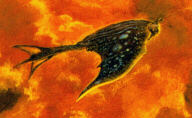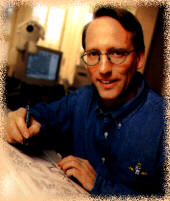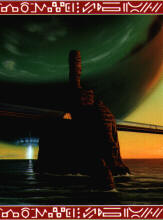

These are the reviews from the early summer of 1997. For newer reviews, go back to the main book page.
There have been a quite a few "futurist" books written lately, many of
them attempting to predict the effects that advanced information technology
will have on our lives. What Will Be is another book of predictions,
written in an engaging style and peppered with interesting anecdotes.
 Prof. Dertouzos is the Director of the MIT
Laboratory for Computer Science, an academic institution that has done
a great deal to help bring about the "information revolution." His leadership
role in the community gives the author impressive credentials for predicting
the future. The reader picking up the book may expect bold and insightful
ideas.
Prof. Dertouzos is the Director of the MIT
Laboratory for Computer Science, an academic institution that has done
a great deal to help bring about the "information revolution." His leadership
role in the community gives the author impressive credentials for predicting
the future. The reader picking up the book may expect bold and insightful
ideas.
First, this book is written for general readers, not for technical sophisticates or professional computer scientists. While it does have some in-depth explanations of some predictions, most of the book is a survey of new technologies and applications we might see in the next 5-20 years. Many of the new technologies and applications that the book contains are complemented with scenarios detailing how our lives might be affected.
Much of What Will Be is related to the idea of the "Information Marketplace," a conception of global virtual commerce and intercourse that the author introduced back in 1981. This unifying concept helps tie some of the themes in the book together, and the predictions associated with the information marketplace seem to have the most depth and insight.
In one particular sub-topic the author makes light of a serious subject (serious to this reviewer, at least), the importance and difficulty of establishing good information security to foster the conduct of personal and government business in the information marketplace. While we do indeed, as the Prof. suggests, have all or most the technology building blocks to establish good security, assembling them into a sturdy edifice will be a huge challenge.
While the ideas and predictions in Prof. Dertouzos's book also appear in other forward-looking books, the presentation here is as good as any. Further, this author is not an outsider looking into the turbulent mists of the future but a swimmer leading our way, and it shows.
Conclusion: Recommended
Justly famous in the science fiction community for his no-nonsense science and intense fiction, Bob Forward strikes again with a creative and exciting novel. Saturn Ruhk is the story of the first manned "landing" on Saturn, and the crew's encounter with the dominant native species.
The novel is divided into essentially three sections: the lead-in, the journey, and the time in Saturn's atmosphere. The first section begins with a clever analogue of Adm. Peary's advertisement for adventurers to reach the north pole, only this one invites applicants for high-paying science experiment: take a rocket-fuel factory to Saturn to test the feasibility of manufacturing fuel from Saturn's copious supplies of gases. Our six main characters accept the challenge, and arrive at the giant planet only a few months later. On arrival, they face the daunting task of "climbing Saturn's rings" down from Titan into Saturn's clouds.
The blending of technical detail and action during the descent through Saturn's moon system is one place where Forward really shines. His descriptions of the devices and trajectories the crew employ is masterful. Similarly, his extrapolation of existing technologies materials into the magic needed to reach Saturn is splendid reading.
After the adventurers reach Saturn, the rapidly encounter the local wildlife, all adapted to floating and flying lifestyles, and all amenable to detached scientific study. Until they encounter a flock of ruhk.

Conclusion: Highly Recommended for fans of hard science fiction.
Scott Adams, shown below, is already a nationally respected portraitist of modern America. In his new book, he takes a humorous/serious stab at predicting the future of our society.
 The Dilbert Future
is structured into a more-or-less independent set of sections, each
consisting of related
chapters explaining a facet of our future.
The actual predictions are boxed and numbered for ease of reference, but
none of the predictions are quantified with a time -- the reader is left
wondering just how long we'll have to wait fulfillment of, for example,
"In the future, your clothes will be smarter than you."
Many of the chapters have cool titles like "Genetically Engineered Children,"
"Clothing of the Future,"
and "Mothers, Don't Let Your Children Grow Up to be Vendors."
The Dilbert Future
is structured into a more-or-less independent set of sections, each
consisting of related
chapters explaining a facet of our future.
The actual predictions are boxed and numbered for ease of reference, but
none of the predictions are quantified with a time -- the reader is left
wondering just how long we'll have to wait fulfillment of, for example,
"In the future, your clothes will be smarter than you."
Many of the chapters have cool titles like "Genetically Engineered Children,"
"Clothing of the Future,"
and "Mothers, Don't Let Your Children Grow Up to be Vendors."
A few of Scott Adams' predictions are insightful and well-reasoned, plus almost all of the predictions are well-supported by Dilbert cartoons. Some of my favorite predictions from the book are listed below; personally, this reviewer has complete faith that they will all come true.
 The mix of Dilbert cartoons, serious writing, funny writing, and
allegedly true stories is a major part of this book's charm. In
some cases, such as with some of the insights about telecommunications,
the author bases his predictions on personal experience and technical
knowledge. In other cases, the author simply makes up some outlandish
"facts" and extrapolates from them. In a few cases, it is difficult
to tell where the ideas are coming from, but the reader may assume
that they come from Nostradogbert (depicted at right), who is
listed as a consultant for the book.
The mix of Dilbert cartoons, serious writing, funny writing, and
allegedly true stories is a major part of this book's charm. In
some cases, such as with some of the insights about telecommunications,
the author bases his predictions on personal experience and technical
knowledge. In other cases, the author simply makes up some outlandish
"facts" and extrapolates from them. In a few cases, it is difficult
to tell where the ideas are coming from, but the reader may assume
that they come from Nostradogbert (depicted at right), who is
listed as a consultant for the book.
Near the end of the book, the Mr. Adams turns more serious, and the reader is treated to a real look into the beliefs and background of one of the top cartoonists of our time.
Conclusion: Recommended; serious Dilbert fans, don't miss it!
The author, an astronomer, presents a straight-forward and readable description of the HST's design goals and capabilities.
The preface was written by John Gribben, a popular science writer, and it presents a summary of the HST's role in observational astronomy and cosmology. The preface also clearly explains the background of the instrument's name: one of its primary missions is to extend cosmological research of which Edwin Hubble was one of the founders.
In a coffee-table book like this one, the quality, selection,
and arrangement of the images is very important. Hubble's Universe
is quite good in this respect. The images range from very good to
stunning in quality. The reproduction quality of the glossy plates is
very good.
 Fitting the book's sub-title, the author chose to
arrange the images roughly in order of distance; the first picture
is one of the planet Mars, and the last is an example of
gravitational lensing by a galaxy cluster 1-2 billion light-years distant.
The only complaint one might raise with respect to the images is
that there aren't more of them - the book contains about 50 pictures.
Fitting the book's sub-title, the author chose to
arrange the images roughly in order of distance; the first picture
is one of the planet Mars, and the last is an example of
gravitational lensing by a galaxy cluster 1-2 billion light-years distant.
The only complaint one might raise with respect to the images is
that there aren't more of them - the book contains about 50 pictures.
If you want nice book of well-chosen and well-printed pictures of planets, stars, and nebulae, you wouldn't go wrong to grab Hubble's Universe. For more information about the HST and more images than you could ever fit in a book, surf over to the Space Telescope Science Institute.
Conclusion: Recommended as a picture book
Books about the universe, time, the big bang, and other facets of large-scale mathematical physics are very popular. Stephen Hawking is largely to be thanked for this, but other authors have done their share, including Kip Thorne, Roger Penrose, Michio Kaku, and many others. In this august company, Timothy Ferris holds his own, and even shines, with deep insights and an infectious enthusiasm for the subject.
The subtitle of this book is A State-of-the-Universe(s) Report. Explaining the entire universe in less than 400 pages is not feasible; instead, Prof. Ferris explains a great deal about our current understanding of the universe. He also gives little capsule descriptions of some of the physicists and astronomers who have contributed to our understanding. The extensive glossary and wealth of explanatory end-notes are also welcome.
This review cannot describe the broad range of topics covered in this book. Just get it.
Conclusion: Highly Recommended
First, an "Excession" is a circumstance or object that is wholly in excess of one's world model. The driver for the plot of the book is an excession that disturbs the equilibrium of a far-future galactic society. (Now, galactic empires are certainly well-covered, even trite, in the sci-fi genre, but Iain Banks manages to display originality and invention even there. His portrayal of the determinedly non-hegemonic "Culture" and the friendly but sadistic "Affront" are subtly brilliant.)
 The Excession also causes a shake-up in the lives of the
main characters. In particular, the man Byr Genar-Hofoen
has a few loose ends to tie up. He is a really good character,
well painted for the reader, and deeper than most science fiction
protagonists.
The Excession also causes a shake-up in the lives of the
main characters. In particular, the man Byr Genar-Hofoen
has a few loose ends to tie up. He is a really good character,
well painted for the reader, and deeper than most science fiction
protagonists.
In this society, space-going vessels and other hardware are usually just as sentient (or more so) than the humans. Iain Banks takes the reader inside the lives and motivations of several "Minds" as the story progresses. Despite their vast intellects, they turn out to be as diverse, conflicted, and divided as the human characters.
In general, a book by Iain Banks makes for fine reading, but not easy reading. The density of ideas and the complexity of the themes might put off someone new to science fiction. For a someone well-read in the genre, Excession is well worth picking up.
Conclusion: Recommended for hard-core science fiction fans only
[Ziring MicroWeb Home] [Neal Ziring] [Julie Ziring] [Ziring Guestbook]
This page written by Neal Ziring, content last modified 7/7/97.